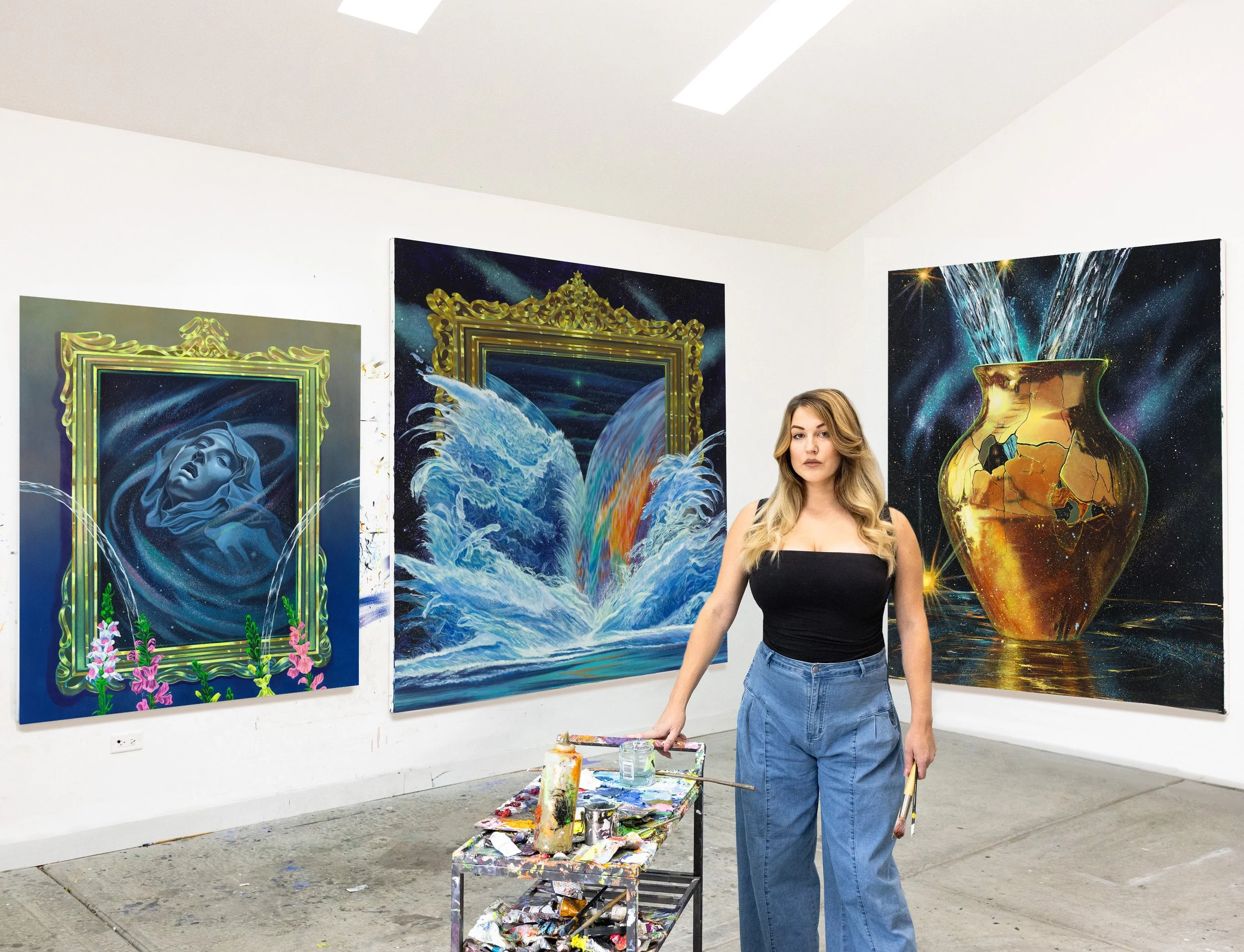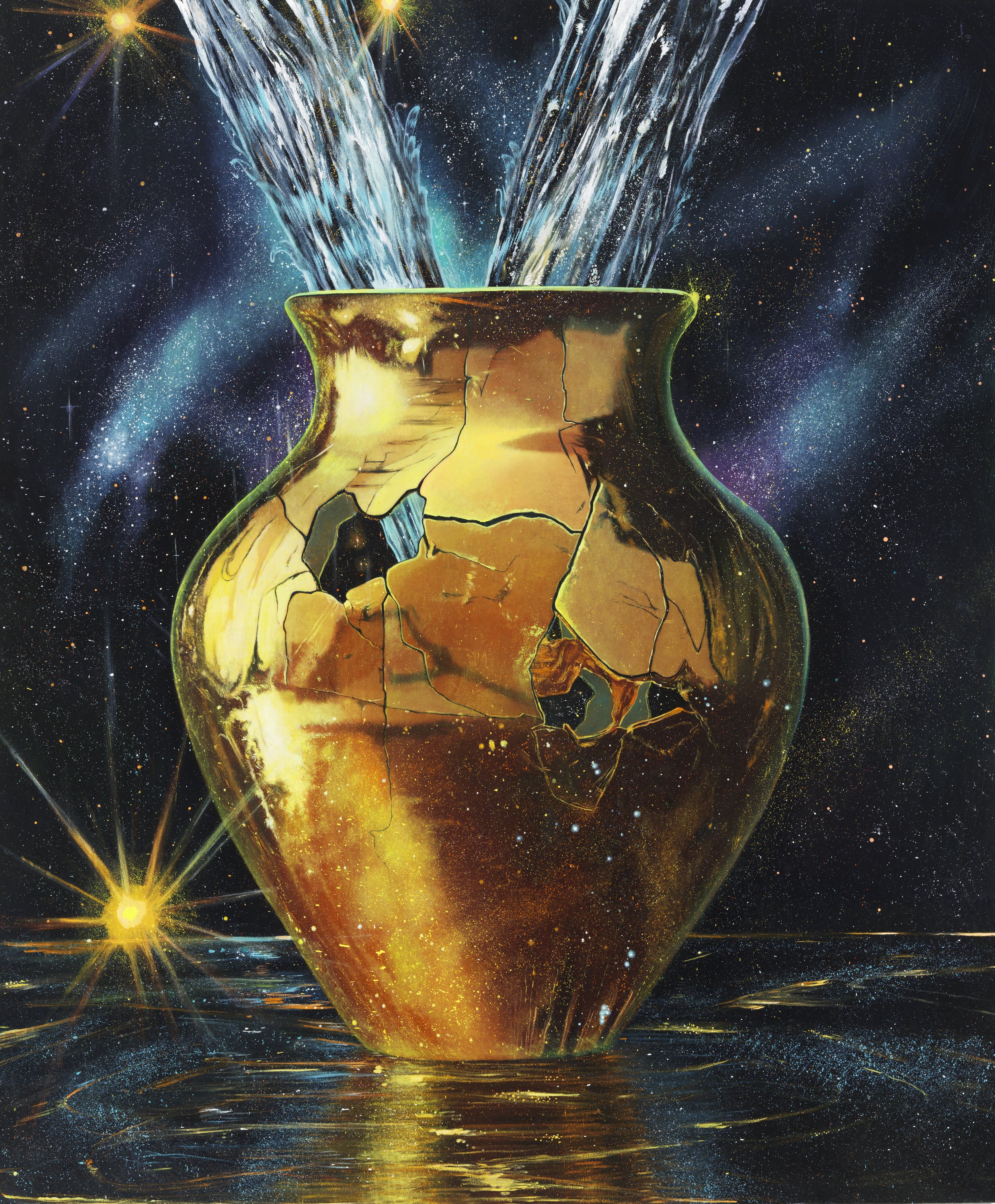Between Neon and the Sacred: Inside the World of Cindy Bernhard
Cindy Bernhard has long stood at the threshold between the visible and the unseen. Her paintings — shimmering with neon palettes, theatrical chiaroscuro, cats, mirrors, and devotional light — move fluidly between hyper-real precision and dreamlike mysticism. Over the years, Bernhard has built a singular visual language rooted in tension: humor and horror, innocence and drama, the earthly and the transcendent.
In this conversation, the Chicago-born artist reflects on the origins of her surreal sensibility, the slow evolution of her signature motifs, and the deepening spiritual dimension that now shapes her practice. Drawing on medieval iconography, digital aesthetics, and the visions of Catholic mystics, Bernhard speaks candidly about painting as meditation, ritual, and revelation — and about how her new series, When the Eternal Breaks Through, marks a pivotal expansion of her universe, both technically and symbolically.
What follows is an intimate look into the mind of an artist for whom painting is not just an image-making process, but a portal into other worlds.
Your work often navigates between hyper-realism and dream logic. When did this fascination with the surreal and cinematic first emerge?
I have always been drawn towards paintings that felt other worldly. I went to a very academic school for undergrad, which was great to develop skills, but I never wanted my work to look photorealistic like lots of my friends in class.
I always figured what's the point in that? I want to make paintings that take viewers to another realm. I remember in class everyone was using earth tones and trying to get the colors to look just like the still life, but my palette was all neons. A professor of mine at the time (now a dear friend) would walk by and say how offensive the colors were to his sensibilities. But, I loved those neons. I remember the first time I saw a Lisa Yuskavage painting, and it rocked my world.
Her dreamlike use of color, and strangely proportioned figures were familiar, yet hard to place. I love paintings that look like they could be of the world we live in, yet there's something otherworldly taking place.
The more I think about it, maybe it's a meshing of the world we live in mixed with the spiritual realm, the realm we can't see with our eyes, but a realm that we feel. I want my work to open doors to other worlds, including my own.
Cats, reflections, and theatrical light have become almost signatures of your visual language. How did these recurring motifs evolve over time?
It took me many years to put the symbols I use in my work together. If I am painting an object I have to have a relationship with it that goes beyond the formal. The object has to mean something to me, in addition to being formally pleasing. So the cat, reflections, gold mirrors, and candles all took time to develop and they are still developing till this day.
Slowly new objects trickle in, and slowly objects fade away. Often they fade away and come back in a new way. The best motifs are ones that can be easily manipulated, like smoke, and more recently water. They are symbolic, but also I can play with its shape due to its malleability. Something that is personal, formal, and can be easily manipulated is "my sweet spot". It takes a long time to develop a visual language as a painter. At least it took a while for me, but probably to outsiders it felt quick.
I tend to be impatient, something I need to work on. I often say all my patience is used up in the studio struggling to make a painting work, and the rest of my life I feel like I am in a race. Unless I am with kids, I have lots of patience for children.
Humor, horror, and tenderness often coexist in your imagery. Do you consciously seek that tension, or does it appear naturally through your process?
I do try and create a type of tension, and I am always interested in opposing forces. I think a lot of artists are. Opposition and tension is what drives great paintings.
I was looking through a sketchbook of mine from graduate school the other day and there were pages of words that create tension. up/down, inside/outside, dark/light, soft/hard, pages of words like this. I think life, overall, is a battle between good and evil, so naturally that tension creeps into the work.
There’s a devotional, almost icon-like quality in many of your compositions — glowing halos, central figures, deep space. Do spirituality or mythology influence you directly?
The more and more time I spend in the studio the more I am becoming aware of just how much the spiritual realm influences my work.
More recently I have been meditating on the word 'transcendence' in the studio. I am extremely interested in spiritual ecstasy and reading about the lives of mystics.
My last exhibition was deeply influenced by St. John of the Cross and his poem, "The Dark Night of the Soul". Most of my time in the studio is spent learning about mystics through lectures and audiobooks. There's nothing more exciting to me than the belief that that life is not it. It's just the beginning, the beginning to something far greater.
You paint with a precision that feels digital, yet everything remains unmistakably human and emotional. How do you reconcile those two worlds — the screen and the brush?
I think it's near impossible for someone my age to be working as an artist and not have the screen impact their work in one way or another. It just happens naturally living at this time. I grew up playing kid pix and making gradients with 'paint bucket'. I am sure anyone near my age reading this knows exactly what I am talking about.
Naturally, I am deeply influenced by the screen, but also by the works of the masters. My favorite paintings are medieval and gothic paintings, it's the first place I go when I visit a museum, then Renaissance,
Which artists — past or present — have shaped the way you think about color, light, or atmosphere?
Past - Giotto, Morandi, Guston
Present - Lisa Yuskavage, Louise Giovanelli, and a lot of my peers in Chicago and friends of mine who are great painters in LA and New York. Chicago has so many great painters!
The emotional core of your paintings often lies in isolation and wonder. Do you see painting as a personal ritual, or more as a conversation with viewers?
I was talking with a great artist at dinner in NY recently about painting being an act of worship, a prayer or meditation of sorts. I think painting is all of these things and so much more.
I think painting has to have a conversation with the artist and the viewer. I dont think it's hard to have a conservation with viewers when painting, just the act of bringing a piece of work into the world that you cared enough to spend time on will connect with viewers.
And just the fact that we are living in the world at the same time as other people and experiencing similar things creates a conversation with viewers. I always say that I want my work to be enjoyed by everyone...art historians and preschool children. I want my work to have a conversation with everyone.
You’ve exhibited widely and built a distinct identity in the contemporary scene. What has been the most pivotal moment of your career so far?
By far the most pivotal moment in my career was when I made my first cat painting, which caught the attention of Richard Heller, and he offered me a solo exhibition. Truly, before that, not many people were paying attention to my work.
But, my work wasn't strong enough yet. I was still in the mud. I say that, but even now the studio is a battlefield. A constant struggle with the canvas, a constant strive to make better paintings then the last. A constant push to work towards the next thing that pushes the work forward.
“When the Eternal Breaks Through” feels both cosmic and intimate — water, mirrors, and light seem to connect heaven and home. What initial idea or emotion sparked this series?
It really stems from the idea of spiritual ecstasy, the altered state of consciousness where you feel a sense of union with the divine with reduced external awareness. In the studio I like to be learning, and I have been learning about catholic mystics recently. Oftentimes they were artists, painters, poets, musicians.
They were deeply connected to the spiritual realm and often experienced visions. I believe all artists are connected to the spiritual realm a bit more than the average person, I think they do feel things more deeply and see things in a bit of a different way then other people. A blessing and a curse. So, the show stems from the idea of spiritual ecstasy.
There's a lecture I listened to maybe 50 times over the last year, and it's called, "When the Eternal Breaks Through" by a Bishop named Robert Barron. His lectures are deeply rooted in philosophy and theology, and he knows much about the mystics.
In this specific lecture he talks about moments when our ordinary reality become transparent to something transcendent and divine. He uses the transfiguration story from Luke's gospel as a central example.
This show seems to expand your universe technically and symbolically. How do these new paintings push your practice beyond your previous series?
Every painting I hope for this, that is, a push in my practice technically and symbolically. These works are a bit different then my previous works, but there are still moments that recall the previous series like cat tails, candles, sheer curtains, cosmos, gold vases, etc. All of my work up until this series has been a search for meaning.
Full disclosure, I spent 18 years as an atheist, really struggling to believe anything outside of this world exists. Today, I feel the spiritual realm is more real than the physical objects I see and touch in day to day life. Because of this, I feel like the possibilities in my work are endless, an entire new word has opened up to me, rushing over me like a great wave.
There’s a strong sense of movement and rupture in these works — water bursting from frames, light slicing through curtains. Is this “breakthrough” more about destruction, revelation, or renewal for you?
I like to believe the "breakthrough" symbolizes only positive things, revelation, renewal, hope, rebirth, purification, healing. The last words I named may be the most important or relevant, purification and healing. I guess as the kids say, I'm "in my healing era".













